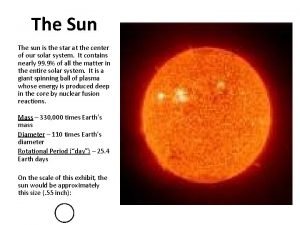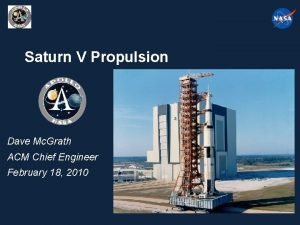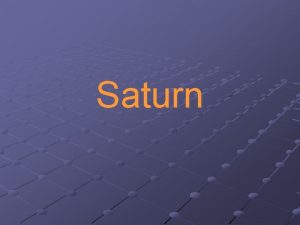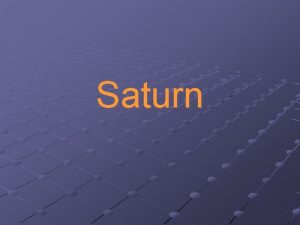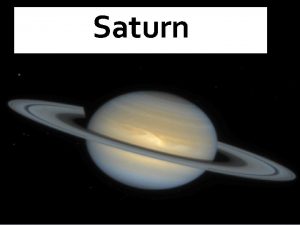Saturn V Pronounced Saturn five NASA USA Saturn











- Slides: 11

Saturn V • Pronounced ‘Saturn five’. • NASA, USA. • Saturn rockets launched Apollo missions to Moon, 1968 to 1972. • Apollo 11 mission launched on 16 July 1969. • Height = 110 m (longer than a rugby field, nearly as tall as the Auckland Sky Tower). • This image is the Apollo 15 launch on 26 July 1971. NASA © Copyright. University of Waikato. All Rights Reserved | www. sciencelearn. org. nz

Titan Centaur • NASA, USA. • Titan Centaur rockets were used to launch the two Voyager probes in 1977. • Height 48 m. NASA-MSFC Voyager probes 1 and 2 • Mass 721. 9 kg. • Flyby of Jupiter in 1979. • Flyby of Saturn in 1980. • Voyager 1 most distant human-made object in space (17, 734, 600, 000 km or 118 AU as at 23 September 2011). • Both continue to send/receive signals as they travel into interstellar space. NASA © Copyright. University of Waikato. All Rights Reserved | www. sciencelearn. org. nz

Space Shuttle • • NASA, USA. 135 flights, 1981 to 2011. Height = 56 m at launch. Carries people and objects such as satellites into Earth orbit. • Used to build and transport to the International Space Station. • Has two solid rocket boosters that separate after 2 minutes. • The big external tank continues to supply propellant to the three main engines on the Space Shuttle orbiter for another 6 minutes. e. Power-Propulsion © Copyright. University of Waikato. All Rights Reserved | www. sciencelearn. org. nz

Soyuz-FG • Russia. • Launches satellites into orbit. • Missions to the International Space Station. • Height = 49. 5 m. • This image is of the TMA-13 mission carrying supplies and three crew to the International Space Station in 2008. NASA/Bill Ingalls © Copyright. University of Waikato. All Rights Reserved | www. sciencelearn. org. nz

Electron • • • Rocket Lab, New Zealand. Height = 17 m. Diameter = 1. 2 m. Peak thrust of 192 k. N. First Electron rocket launch test was on 25 May 2017, which made New Zealand the 11 th nation to launch a satellite. • Focus is on launch services for the growing small-satellite industry. • The primary components of the engine are 3 D printed. • Battery-driven fuel pumps. © Copyright. University of Waikato. All Rights Reserved | www. sciencelearn. org. nz

Falcon rocket vehicles • Space Exploration Technologies (Space. X), USA. • Multi-use rocket launch vehicles. • Falcon 1– first successful flight was on 28 September 2008. Further development is currently on hold as the development focus is on the larger Falcon 9. • Falcon 9 is designed for vertical landing. • Falcon Heavy, a three-core variant, was launched on 6 February 2018. Its three boosters are designed to be recovered and reused. Space. X © Copyright. University of Waikato. All Rights Reserved | www. sciencelearn. org. nz

International Space Station NASA • The International Space Station (ISS) is the size of a rugby field. • Astronauts live on board for up to 6 months at a time. • Huge solar panels generate energy from the Sun. • Altitude is 360 kilometres above the Earth’s surface. • Orbital speed of 28, 000 kilometres per hour. • It takes 90 minutes to go around the Earth once. Astronauts experience 16 day/night cycles every 24 hours! NASA © Copyright. University of Waikato. All Rights Reserved | www. sciencelearn. org. nz

Scale model distances If the Earth was just 10 cm diameter, what would be: NASA • the thickness of the atmosphere? • the distance to the International Space Station? • the diameter of the Moon? • the distance to the Moon? • the diameter of the Sun? • the distance to the Sun? © Copyright. University of Waikato. All Rights Reserved | www. sciencelearn. org. nz

Scale model distances Object Real distance (km) Diameter of Earth 12 , 756 Thickness of 99% of Earth’s atmosphere Scale model 10 cm 31 0. 2 mm Official start of space 100 0. 8 mm Altitude of the International Space Station 360 2. 8 mm Diameter of the Moon 3 , 475 2. 7 cm Distance to the Moon 385, 000 3. 0 m Diameter of the Sun 1, 392, 000 10. 9 m 150, 000 1. 2 km Distance to the Sun from Earth © Copyright. University of Waikato. All Rights Reserved | www. sciencelearn. org. nz

Questions to consider • What makes a rocket start moving? • What keeps a rocket moving once the rocket engines have finished? • Why do some rockets stay in space and some fall back to the Earth? • What challenges does the New Zealand space industry face? • What countries have launched rockets into space? • What are some of your favourite images from space (e. g. Hubble Space Telescope images)? • What are some of NASA’s current and future missions? © Copyright. University of Waikato. All Rights Reserved | www. sciencelearn. org. nz

The Science Learning Hub would like to thank NASA, e. Power-Propulsion, Rocket Lab and Space. X for the use of their images for this activity. © Copyright. University of Waikato. All Rights Reserved | www. sciencelearn. org. nz
 S/es pronunciation
S/es pronunciation Words that are spelled the same but pronounced differently
Words that are spelled the same but pronounced differently Words that are spelled the same but pronounced differently
Words that are spelled the same but pronounced differently Van gogh pronounced van goff
Van gogh pronounced van goff Likido ang ikinabubuhay hangin ikinamatay
Likido ang ikinabubuhay hangin ikinamatay Calipso data download
Calipso data download One in five challenge
One in five challenge 5 senses and 5 elements
5 senses and 5 elements Macbeth
Macbeth And all its aching joys are now no more
And all its aching joys are now no more The sun is the star at the center of the solar system
The sun is the star at the center of the solar system Saturn x mc
Saturn x mc










